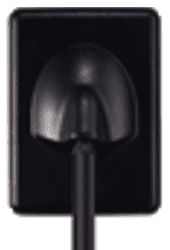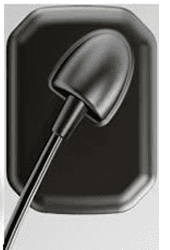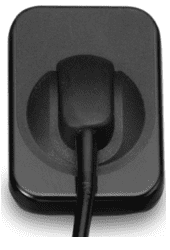Objective
Infection control is in the news. And, while FDA-approved barriers provide important protection, the CDC and ADA each call for cleaning between patients:
To minimize the potential for device-associated infections, after removing the barrier, the device should be cleaned and disinfected with an EPA-registered disinfectant (intermediate-level) after each patient. *
So:
- Does the sensor design avoid crevices which take more effort and time to clean?
- Is the sensor immersible in cold sterilants?
Design
Ease Of Cleaning. Time spent cleaning a sensor is time away from patients. So a sensor which is easier to clean may improve patient care and practice production. Therefore, XDR paid special attention to the cord-attachment button, where most sensors have creases or crevices. In response, XDR designed the Anatomic Sensor to have a smooth transition from button to sensor plate.
|
|
 |
 |
 |
 |
| Figure 2 – Competitive cord-attachment buttons, showing transitions | |||
Waterproof. If a barrier should break, it would be good to know you can immerse your sensor in a cold sterilant. Therefore, XDR designed the Anatomic Sensor to be hermetically sealed and therefore waterproof.
|
|
Results
Ergonomic Features
| Objective | Feature |
| Canine-Premolar Contact | Maximal Mesial Imaging Area |
| Intraoral Visibility | White Face |
| Comfort | Rounded Corners |
| Comfort | Beveled Corners |
| Ease of Placement | Thin |
| Ease of Placement | Small Button |
| Ease of Cleaning | No Creases or Crevices |
| Waterproof | Hermetically Sealed; Immersible |
| Strong Cord | Kevlar Cable |
| Shock Resistance | Protection Plate |
| Handling Ease | Two-Meter Cord |
Conclusion
Many sensors address some of the ergonomic issues. Only the XDR Anatomic Sensor addresses all of these issues.
* References:
- Kohn, W. G., Collins, A. S., Cleveland, J. L., Harte, J. A., Eklund, K. J., & Malvitz, D. M. (2003). Guidelines for infection control in dental health-care settings–2003. MMWR Recomm Rep, 52(17), 1-61.
- American Dental Association (ADA). 2016. Oral Health Topics Infection Control [Internet]. ADA.org; [cited 2016 October 6]. Available from http://www.ada.org/en/member-center/oral-health-topics/infection-control-resources

